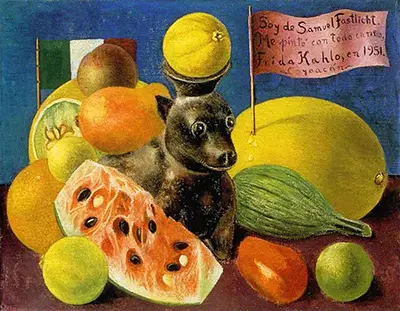The painting shows a range of citrus and tropical fruit surrounding what appears to be a ceramic dog. The dog also has an extruded bowl above its head with a piece of fruit sitting on top. Behind the fruit, we see what appears to be the Mexican flag. Her use of colour in this painting is playful and full of vibrant colours. Citrus and melons can be seen in bright reds, greens, oranges, and yellows.
Some fruit, such as the watermelon, are sliced to show a greater level of detail such as the seeds and the white and red colours found in a watermelon. Notice the indented black and white seeds found within the watermelon. The bumps and edges around the surface are realistic. Contrasting the vibrant colours of the fruit, the ceramic dog in the centre is a rich and deep brown. Although the dog is located at the centre of the painting, the bright and colourful fruit surrounding the dog guide the viewer’s attention away to the left and right of the dog.
Planted in a whole honeydew we see a banderole which has the following inscription in Spanish "Soy de Samuel Fastlicht. Me pintó con todo cariño por Frida Kahlo en 1951. Coyoacán." Translated into English this reads "I belong to Samuel Fastlicht. I was painted with great affection by Frida Kahlo in 1951. Coyoacán." Coyoacán is where Frida Kahlo was born and also where she spent the last 13 years of her life. Her affection for the dentist is clear, as she painted another work, Self-Portrait with Medallion in 1948 for Dr. Fastlicht.
Samuel Fastlicht was a dentist of European origin who arrived in Mexico in 1921. He contributed to the understanding of dentistry in Pre-Columbian Mexico, whereby the native peoples herbal medicine in dentistry. This work was completed in 1951 for Dr. Fastlicht as payment for dental work that he completed on Frida Kahlo. The medium is oil on canvas and it currently belongs to the private collection of Dr. Samuel Fastlicht.

